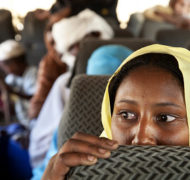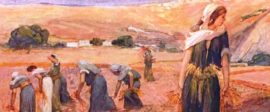Course Module in OT - Economics and Contemporary Workplace Issues in Ruth
Seminary Curriculum / Produced by TOW Project
Workplace Lessons from Ruth 2 |
The Old Testament book of Ruth is familiar to many, if not most, Christians. But it doesn’t have a large place in theological curricula. This beloved book could be a helpful way to lead students to grasp God’s intentions for daily life and work – and it’s a great story they can use in sermons to make those lessons vivid for their future congregations!
Ruth appears in most collections of Bible stories for children because of the tragedies and uncertainties that unfold in this simple and engaging narrative. Theologically, the story of Ruth is remarkable because it leads, through her descendant David, to Ruth’s appearing in Matthew’s genealogy of Jesus – a surprising place for the name of a Moabite woman to surface. And sermons about conversion and commitment are frequently preached from the words of that marvellous confession from Ruth to Naomi: “Your people shall be my people and your God shall be my God…”
But Ruth can also help Old Testament classes engage major contemporary issues, particularly issues of work and business. Where else in the Bible do you find – in just four short chapters! – stories of:
- Border crossings to escape famine
- Cross-cultural marriages and inter-religious relationships
- Vulnerable widows struggling with life and faith in the face of death
- An immigrant among God’s people
- A solution to poverty that transcends welfare
- Protection against workplace sexual harassment
- Love, marriage and the astute management of complex family relationships and delicate business negotiations?
This potential source of wisdom is too seldom explored for issues like these.
Migrants Seeking Sanctuary
Elimelech and Naomi moved from Bethlehem to the country of Moab, with their two sons, when their crops failed (Ruth 1:1-2). No longer able to provide food through their own work, this family was forced to look for food and work in another country.
The long history of enmity between Israel and Moab reinforces the sense of desperation that lies behind this move. Desperation forced them to move to a potentially hostile country through no fault of their own, and this creates dilemmas for those who move and those who end up hosting them.
There is certainly a contemporary ring to these challenges in the light of current debates about how much hospitality we should offer refugees and migrants. But there is also a reminder that the Old Testament laws demanding hospitality towards widows, the poor and foreigners (to which Naomi will appeal later when they return to Israel) are accompanied by the reminder “for you were once foreigners seeking refuge in Egypt”(Deut 10:18-19, 16:11-12, 24:17-18).
So try throwing this question at your students: Most people got where they are from some other place, if you go back far enough. Does this story suggest that relatively free movement of people is, at least in most circumstances, something God favors?
Challenges, Death And Disappointment
Having moved to Moab, Elimelech and Naomi face the challenge of cross-cultural marriages and inter-religious relationships. While this theme is not explored in depth in this book, still we see their consequences in the hard choices Naomi, Ruth and Orpah are forced to make. They are pulled between home, commitment to one another and the opportunities and risks associated with moving (Ruth 1:4-18).
Forced migration – an all too common economic reality in less prosperous societies – inevitably involves a mixture of grief and relief about what has been left behind and also hope and anxiety about what might lie ahead. There are many conflicting emotions to be dealt with. Interestingly, in response to the events in this case, a more hopeful affirmation of faith comes from Ruth the Moabite, while we find Naomi the Israelite struggling to come to terms with the hand full of disappointments God has dealt her (Ruth 1:14-21). The vibrant faith of immigrants can stand in sharp contrast to the tepid faith of their hosts.
Providing Food And Providing Work
Old Testament Laws were formulated to protect the survival of families and ensure their ability to maintain a livelihood, even where previous generations had lost their land. This included levirate marriage and a process for redemption of land, although neither of these immediately succeeds for Ruth and Naomi. Instead, Ruth is forced to work as a farm laborer gathering grain behind the harvesters.
She finds herself working in a field that belongs to Boaz, a relative of her father-in-law Elimelech. Having gathered barley in Boaz’s field all day, Ruth spends the evening beating out the grain until it fills an entire basket. She carries it back into the town and shows it to her mother-in-law, giving Naomi the roasted grain that is left over from the evening meal that Boaz shared with Ruth.
What happens here is a combination of providing one-way assistance (food) and mutual assistance (work). This assistance is partly the result of obligations for landowners laid down in the Old Testament laws related to gleaning. It was prescribed that the corners of fields should be left for the poor to harvest.
Boaz goes further than the law prescribes by also encouraging his workers to leave out extra grain for Ruth and sharing his evening meal with her, even enough for Ruth to take some home to feed Naomi. Nonetheless, Ruth still has to work hard for what she is able to collect. Every day she is back, working from morning to dusk until all the barley and wheat is harvested.
It is a fascinating combination of biblically legislated means of mutual assistance, personal generosity on the part of Boaz and hard work by Ruth to collect and winnow the grain that has been made available to her. Here, surely, is a model for helping those in need that is worth discussing with students! It is also an opportunity to discuss how much of a duty Christians should feel to help foreign co-workers and other vulnerable people fit into a new workplace.
Highly relevant to our current context and the needs of theological education, Ruth engages the issues of migration, ethical economics and faithful forms of assistance for those in need. As seminary faculty and as members of the Theology of Work Bible Commentary editorial team, we find that the book of Ruth stands out as a very useful resource for theological discussion of work and economic issues. And of course we commend the free Theology of Work Bible Commentary on Ruth in hopes you will find it of further help in the classroom!
RUTH AND THE CONTEMPORARY WORKPLACE
As we have seen, the book of Ruth has implications for ethics, economics and workplace environments. Theological students need to understand how biblical books like Ruth can inform the way Christians think about and live out their lives in the workplace.
Guarding Against Harassment In The Workplace
In this story there are two people – Naomi and Boaz – very concerned about Ruth’s safety and reputation, particularly regarding the danger of sexual harassment. In Ruth 2:22, Naomi makes plain that Boaz, as a relative, has an obligation to help look after Ruth, saying, “It is good that you can pick up grain alongside the women who work in his field. Who knows what might happen to you in someone else’s field.” Boaz himself goes to Ruth and says “I think it would be best for you not to pick up grain in anyone else’s field. Stay here with the women….I have warned the men not to bother you” (Ruth 2:8).
In the light of the romantic direction this story takes it is easy to assume that more personal reasons lead to Boaz’s protection of Ruth. But these words were said when they first met and probably should be understood as the genuine concern of a conscientious businessperson taking care of those who work in his organization – particularly this solitary, vulnerable, foreign, female migrant. Boaz turns his personal concern into a workplace policy by advising his other workers how to treat Ruth and also advising Ruth where she is likely to be safe. Like Boaz, Christians are called to both refrain from harassment and to create, as much as possible, safe work environments.
Full Inclusion In The Workplace
Boaz does much more than protect Ruth from sexual harassment. He invests in her full inclusion in the workforce. Ruth is to have equal access to water (Ruth 2:9) and to the lunch table (Ruth 2:14). At meal time, Boaz invites Ruth to come sit with him and his workers and to dip her morsel of bread in his sauce (Ruth 2:14). Then he serves her until she is more than satisfied. The regular employees are to make Ruth’s work environment as secure as possible and to go out of their way to assist her in achieving her work tasks (Ruth 2:15–16).
Boaz’s actions are an investment in Ruth’s productivity. As a member of the work group, she could come up to speed on the best practices for each crop according to the local conditions, which would be different from what she was trained to do in Moab. She learned how to work both the barley harvest and the wheat – developing skills in multiple areas, or cross-training in today’s business terminology. In the group she could benefit from teamwork rather than having to perform every task on her own.
Today, managers and co-workers can invest time, skill and care in helping new workers become integrated into work groups, or they can leave newcomers to fend for themselves. Organizations can develop systems for “onboarding” new employees, or leave the task to the whims and chances of each manager and team. This is an issue not only of productivity, but also justice. If an organization invests in the successful integration of high-status workers – or conversely does little or nothing to assist vulnerable, minority, or non-traditional workers – it fails to respect the image of God in each worker.
As seminary faculty and members of the Theology of Work Bible Commentary editorial team, we have found that the book of Ruth stands out as a useful resource for the exploration and discussion of faith, work and economics issues in the seminary classroom. And of course we commend the free, online Theology of Work Bible Commentary on Ruth to assist you in this.
ASSIGNMENT
- Explain how Boaz applied the law given in Leviticus 19:9-10, Leviticus 23:22, Deuteronomy 24:19-22, and Exodus 23:10-11 in the case of Ruth. To what degree did he fulfill the requirements of the law? To what degree did he go beyond the requirements of the law?
- Imagine you are proposing legislation to reform welfare in your State. What would be the main features of your proposal in the light of the Leviticus and Ruth passages?
- Imagine that you own a company that employs a number of staff. What would you do to aid unemployed or underemployed people in the light of the Leviticus and Ruth passages and the need to make a profit?








